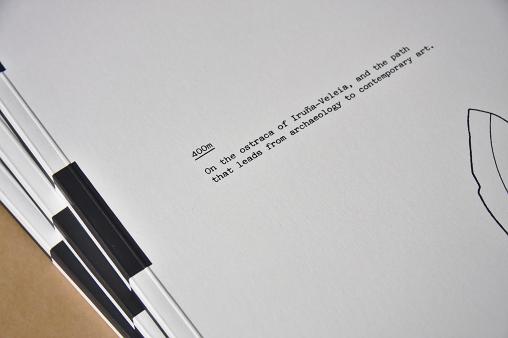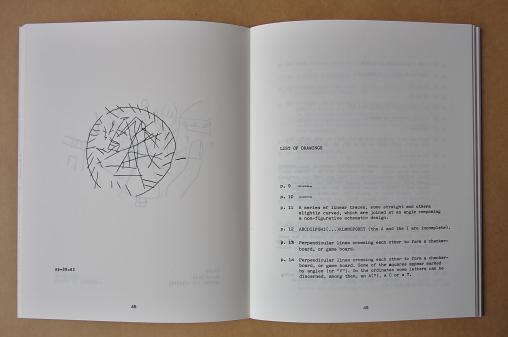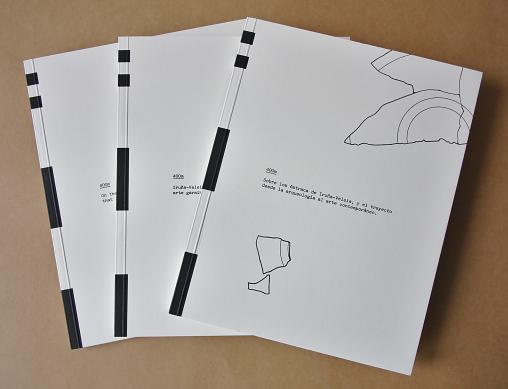400m
On the ostraca of Iruña-Veleia, and the path that leads from archaeology to contemporary art.
400m is the distance between the museum of archaeology and the museum of contemporary art in Vitoria-Gasteiz, in Basque Country. It is also the title of our new book on the controversy surrounding the archaeological discovery of the "ostraca" from Iruña-Veleia: Roman potsherds with engravings of images, texts in Latin and what appeared to be the earliest written manifestation of the Basque language, which were deemed a forgery by a select commission of academic experts.
The book will be presented for the first time at the exhibition "The Materiality of the Invisible" in the Van Eyck Academy, and will be for sale during the annual convention of the European Association of Archaeologists taking place in Maastricht from 30 August to 3 September.
With texts by Iñaki Martínez de Albéniz, Harkaitz Cano, Iratxe Jaio and Klaas van Gorkum.
Printed with a mimeograph at the Charles Nypels Lab in the Van Eyck Multiform institute for fine art, design and reflection.
Introduction chapter from the book:
Sealed in boxes and locked away inside the archaeological museum of Álava, Basque Country, are the so-called ostraca of Iruña-Veleia: hundreds of little fragments of ancient Roman pottery, into which marks have been scratched. Some appear as mere blemishes, accidental traces, and are hardly legible as signs. But upon careful reading these lines turn into drawings, drawings into symbols, symbols into letters, writing, and text.
A careful reading ascribes meaning to these things. There are human figures. There are numbers and alphabets. There are names of people, and names of gods. There are Latin phrases and even what appears to be an early form of the Basque language.
These ostraca were discovered in 2006, but were never exhibited in public. After examination by a select committee of academics, the inscriptions were declared the product of an elaborate forgery. Not everyone agreed with this conclusion. A fierce argument broke out between “veristas” and “falsistas”. And for the last ten years they have not stopped quarrelling over the historical significance of the engravings.
In 2016 the artists Iratxe Jaio and Klaas van Gorkum submitted a formal loan application to the competent authorities, requesting the original items for an exhibition in Artium, the Museum for Contemporary Art of Álava. Their objective was a conceptual, as well as a physical displacement of the contested objects, that would allow for interpretations and readings beyond the binary opposition between false and genuine.
The authorities have conveyed that while the pieces are still subject of a trial to determine whether fraud was committed, they cannot grant permission to transfer them between the museums.
Anticipating that this legal process must eventually come to an end, the artists organised a symposium at the museum for contemporary art in preparation for the hypothetical exhibition. A group of people was invited to reflect on the absence of the artefacts, and to engage the public in a discussion on how to become involved in the institutional processes that determine the fate of its own material culture.
This book contains some of their recommendations. It has been printed with a mimeograph, an obsolete technique in which marks are scratched with a stylus, or punched by a typewriter, into a special wax-covered stencil, after which ink is pressed through. Marks that upon careful reading turn into drawings, drawings into symbols, symbols into letters, writing, and text.
A careful reading ascribes meaning to these things. But beware. Things are not always what they seem. Behind words that parade as unsolicited advice, run fundamental doubts concerning the relationship between authority and knowledge, teacher and pupil, reader and writer.
Acknowledgments
The book has been printed at the Jan van Eyck Academy in Maastricht, with kind assistance from Jo Frenken, head of the Charles Nypels Lab, and Erwin Blok, expert in mimeograph technology. It was realized with financial support from Artium, Basque Museum-Center of Contemporary Art; Azala Kreazio Espazioa; CBK Rotterdam (Center for Visual Arts Rotterdam); Eremuak; and the Van Eyck, Multiform institute for fine art, design and reflection.
The artists would also like to thank all the members of their ad hoc “think tank”, for their thoughtful feedback and carefully prepared presentations during the symposium: Idoia Zabaleta, Ixiar Rozas, Ane Lekuona, Amaia Carballo, Andere Olaso, Enrique Martínez, Haizea Barcenilla, Xurxo Ayán, Iñaki Martínez de Albeniz, Harkaitz Cano, Imanol Agote, and Daniel Castillejo.










